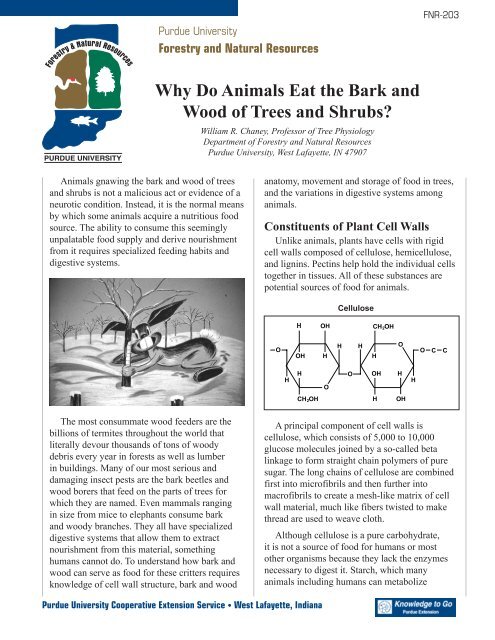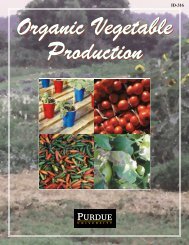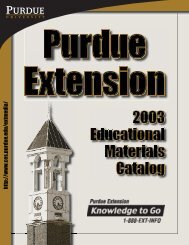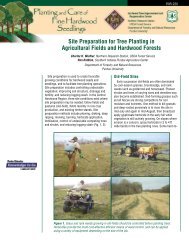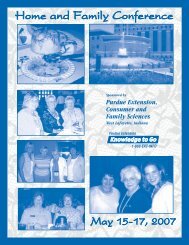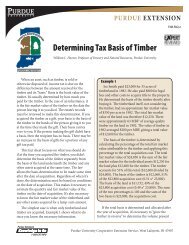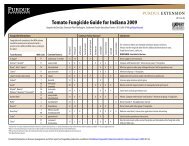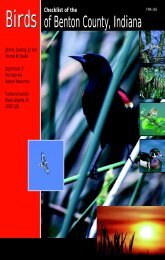Why Do Animals Eat the Bark of Trees and Shrubs? - Purdue ...
Why Do Animals Eat the Bark of Trees and Shrubs? - Purdue ...
Why Do Animals Eat the Bark of Trees and Shrubs? - Purdue ...
You also want an ePaper? Increase the reach of your titles
YUMPU automatically turns print PDFs into web optimized ePapers that Google loves.
Forestry & Natural Resources<br />
PURDUE UNIVERSITY<br />
<strong>Purdue</strong> University<br />
Forestry <strong>and</strong> Natural Resources<br />
<strong>Animals</strong> gnawing <strong>the</strong> bark <strong>and</strong> wood <strong>of</strong> trees<br />
<strong>and</strong> shrubs is not a malicious act or evidence <strong>of</strong> a<br />
neurotic condition. Instead, it is <strong>the</strong> normal means<br />
by which some animals acquire a nutritious food<br />
source. The ability to consume this seemingly<br />
unpalatable food supply <strong>and</strong> derive nourishment<br />
from it requires specialized feeding habits <strong>and</strong><br />
digestive systems.<br />
The most consummate wood feeders are <strong>the</strong><br />
billions <strong>of</strong> termites throughout <strong>the</strong> world that<br />
literally devour thous<strong>and</strong>s <strong>of</strong> tons <strong>of</strong> woody<br />
debris every year in forests as well as lumber<br />
in buildings. Many <strong>of</strong> our most serious <strong>and</strong><br />
damaging insect pests are <strong>the</strong> bark beetles <strong>and</strong><br />
wood borers that feed on <strong>the</strong> parts <strong>of</strong> trees for<br />
which <strong>the</strong>y are named. Even mammals ranging<br />
in size from mice to elephants consume bark<br />
<strong>and</strong> woody branches. They all have specialized<br />
digestive systems that allow <strong>the</strong>m to extract<br />
nourishment from this material, something<br />
humans cannot do. To underst<strong>and</strong> how bark <strong>and</strong><br />
wood can serve as food for <strong>the</strong>se critters requires<br />
knowledge <strong>of</strong> cell wall structure, bark <strong>and</strong> wood<br />
<strong>Why</strong> <strong>Do</strong> <strong>Animals</strong> <strong>Eat</strong> <strong>the</strong> <strong>Bark</strong> <strong>and</strong><br />
Wood <strong>of</strong> <strong>Trees</strong> <strong>and</strong> <strong>Shrubs</strong>?<br />
William R. Chaney, Pr<strong>of</strong>essor <strong>of</strong> Tree Physiology<br />
Department <strong>of</strong> Forestry <strong>and</strong> Natural Resources<br />
<strong>Purdue</strong> University, West Lafayette, IN 47907<br />
<strong>Purdue</strong> University Cooperative Extension Service • West Lafayette, Indiana<br />
FNR-203<br />
anatomy, movement <strong>and</strong> storage <strong>of</strong> food in trees,<br />
<strong>and</strong> <strong>the</strong> variations in digestive systems among<br />
animals.<br />
Constituents <strong>of</strong> Plant Cell Walls<br />
Unlike animals, plants have cells with rigid<br />
cell walls composed <strong>of</strong> cellulose, hemicellulose,<br />
<strong>and</strong> lignins. Pectins help hold <strong>the</strong> individual cells<br />
toge<strong>the</strong>r in tissues. All <strong>of</strong> <strong>the</strong>se substances are<br />
potential sources <strong>of</strong> food for animals.<br />
Cellulose<br />
A principal component <strong>of</strong> cell walls is<br />
cellulose, which consists <strong>of</strong> 5,000 to 10,000<br />
glucose molecules joined by a so-called beta<br />
linkage to form straight chain polymers <strong>of</strong> pure<br />
sugar. The long chains <strong>of</strong> cellulose are combined<br />
first into micr<strong>of</strong>ibrils <strong>and</strong> <strong>the</strong>n fur<strong>the</strong>r into<br />
macr<strong>of</strong>ibrils to create a mesh-like matrix <strong>of</strong> cell<br />
wall material, much like fibers twisted to make<br />
thread are used to weave cloth.<br />
Although cellulose is a pure carbohydrate,<br />
it is not a source <strong>of</strong> food for humans or most<br />
o<strong>the</strong>r organisms because <strong>the</strong>y lack <strong>the</strong> enzymes<br />
necessary to digest it. Starch, which many<br />
animals including humans can metabolize
2<br />
because <strong>the</strong>y produce amylase enzymes, is similar<br />
to cellulose except <strong>the</strong> long chains <strong>of</strong> glucose are<br />
linked in an alpha configuration. Cellulose has as<br />
much food value as starch, but only animals that<br />
maintain colonies <strong>of</strong> microorganisms in <strong>the</strong>ir gut<br />
that produce <strong>the</strong> enzyme cellulase are capable <strong>of</strong><br />
digesting it.<br />
A second important constituent <strong>of</strong> plant cell<br />
walls is hemicellulose, which bonds cellulose<br />
fibrils toge<strong>the</strong>r. Hemicellulose also is a polymer,<br />
but it’s more complex than cellulose because <strong>the</strong><br />
molecule is highly branched instead <strong>of</strong> straightchained<br />
<strong>and</strong> consists <strong>of</strong> a mixture <strong>of</strong> several kinds<br />
<strong>of</strong> sugars. Only animals with microorganisms in<br />
<strong>the</strong>ir gut that produce hemicellulase enzyme can<br />
use this substance as food.<br />
Lignin<br />
Lignin,<br />
occurring within<br />
<strong>the</strong> cell wall<br />
matrix formed<br />
by cellulose <strong>and</strong><br />
hemicellulose,<br />
serves as a<br />
binding agent<br />
to hold <strong>the</strong> cells<br />
toge<strong>the</strong>r <strong>and</strong> imparts rigidity to tissues. The s<strong>of</strong>t<br />
nature <strong>of</strong> cotton, practically pure cellulose, is an<br />
indication <strong>of</strong> how flexible wood would be without<br />
a stiffening ingredient like lignin. Lignin is a<br />
complex polymer built <strong>of</strong> phenylpropane units.<br />
Due to its phenolic nature (phenols are <strong>of</strong>ten used<br />
as disinfectants), lignin tends to make wood less<br />
digestible even for animals adapted to feeding on<br />
woody tissues.<br />
The middle lamella located between cells<br />
functions somewhat as a cementing material to<br />
hold adjacent cells toge<strong>the</strong>r. It consists <strong>of</strong> pectins<br />
<strong>and</strong> pectic acids that upon breakdown yield<br />
galacturonic acid <strong>and</strong> <strong>the</strong> sugars arabinose <strong>and</strong><br />
galactose.<br />
All <strong>of</strong> <strong>the</strong>se cell wall materials are potential<br />
sources <strong>of</strong> food if <strong>the</strong> proper enzymes are<br />
available to digest <strong>the</strong>m into <strong>the</strong>ir basic sugar <strong>and</strong><br />
organic acid components.<br />
<strong>Bark</strong> Anatomy<br />
<strong>Bark</strong> consists <strong>of</strong> accumulations <strong>of</strong> crushed,<br />
dead cells <strong>of</strong> <strong>the</strong> outer bark <strong>and</strong> <strong>the</strong> inner bark<br />
<strong>of</strong> living cork cambium <strong>and</strong> functional phloem<br />
tissues that transport sugars throughout trees. The<br />
thickness <strong>and</strong> appearance <strong>of</strong> bark varies widely<br />
among different kinds <strong>of</strong> trees <strong>and</strong> depends on <strong>the</strong><br />
relative activity <strong>of</strong> cork cambium <strong>and</strong> <strong>the</strong> amount<br />
<strong>of</strong> fibers produced in <strong>the</strong> phloem. The dead outer<br />
bark, regardless <strong>of</strong> its thickness, is <strong>the</strong> least<br />
palatable because <strong>the</strong> cell walls are high in lignin,<br />
phenols, <strong>and</strong> <strong>the</strong> waxy substance suberin.<br />
The inner bark, in contrast, has living cells<br />
with nutrient laden cell sap, organelles, <strong>and</strong> stored<br />
starch. Most importantly, <strong>the</strong> phloem cells with<br />
<strong>the</strong>ir sugary contents are located here. The inner<br />
bark is <strong>the</strong> chief target for animals that feed on<br />
bark. Young twigs <strong>and</strong> branches are preferred<br />
because <strong>the</strong>y have a higher proportion <strong>of</strong> inner<br />
to outer bark <strong>and</strong> lower concentrations <strong>of</strong> antidigestion<br />
compounds such as lignin <strong>and</strong> phenols.<br />
There are considerable differences among species<br />
<strong>of</strong> trees, but all barks contain sugars, starch,<br />
cellulose, hemicellulose, <strong>and</strong> mineral elements.<br />
Wood Structure<br />
The functional xylem or wood <strong>of</strong> trees extends<br />
from near <strong>the</strong> tips <strong>of</strong> twigs to near <strong>the</strong> tips <strong>of</strong><br />
roots. When mature, <strong>the</strong> water conducting xylem<br />
vessels <strong>and</strong> tracheids are dead <strong>and</strong> hollow. The<br />
only nutritional value <strong>of</strong> <strong>the</strong>se cells is in <strong>the</strong><br />
lignified cell walls. The xylem also contains<br />
parenchyma cells that constitute <strong>the</strong> vascular rays<br />
as well as being located around vessels, at <strong>the</strong><br />
boundaries between annual rings, or just scattered<br />
among <strong>the</strong> vessels <strong>and</strong> tracheids. In <strong>the</strong> functional<br />
Relative position <strong>of</strong> bark <strong>and</strong> xylem tissues in a tree trunk
part <strong>of</strong> <strong>the</strong> xylem, <strong>the</strong> sapwood, parenchyma<br />
cells are alive <strong>and</strong> used for storage <strong>of</strong> starch. The<br />
heartwood, in contrast, has no living cells <strong>and</strong><br />
<strong>the</strong> starch is replaced with resins <strong>and</strong> phenols that<br />
deter fungal decay <strong>and</strong> insect feeding. Hence,<br />
<strong>the</strong> sapwood is <strong>the</strong> most appealing <strong>and</strong> digestible<br />
part <strong>of</strong> <strong>the</strong> xylem for wood feeders with its stored<br />
starch <strong>and</strong> water conducting cells containing only<br />
small amounts <strong>of</strong> anti-digestion compounds.<br />
The vascular cambium is <strong>the</strong> lateral meristem<br />
from which both new xylem <strong>and</strong> phloem cells<br />
arise. The succulent, exp<strong>and</strong>ing new xylem <strong>and</strong><br />
phloem cells produced by <strong>the</strong> vascular cambium<br />
become a sink for sugars <strong>and</strong> amino acids, making<br />
<strong>the</strong>m particularly attractive as a food source.<br />
Movement <strong>and</strong> Storage<br />
<strong>of</strong> Food in <strong>Trees</strong><br />
Some <strong>of</strong> <strong>the</strong> sugar produced by photosyn<strong>the</strong>sis<br />
is used for growth at its site <strong>of</strong> syn<strong>the</strong>sis, but<br />
most is transported via <strong>the</strong> phloem to o<strong>the</strong>r sites<br />
to sustain growth or for storage in <strong>the</strong> branches,<br />
trunk, fruits, <strong>and</strong> roots. The phloem, located in<br />
<strong>the</strong> inner bark, extends throughout trees from<br />
<strong>the</strong> small twigs in <strong>the</strong> crown to <strong>the</strong> fine roots.<br />
Analysis <strong>of</strong> <strong>the</strong> watery sap coursing through<br />
<strong>the</strong> cells <strong>of</strong> <strong>the</strong> phloem reveals that sucrose is<br />
<strong>the</strong> principal form in which photosynthate is<br />
translocated, but sorbitol, mannitol, raffinose,<br />
stachyose, verbascose, <strong>and</strong> even amino acids<br />
also occur. Surplus quantities <strong>of</strong> <strong>the</strong>se sugars are<br />
stored in living parenchyma cells in <strong>the</strong> roots <strong>and</strong><br />
in <strong>the</strong> sapwood <strong>of</strong> <strong>the</strong> branches <strong>and</strong> trunk <strong>of</strong> trees,<br />
usually as starch. Renewal <strong>of</strong> tree growth in <strong>the</strong><br />
spring is dependent on this stored food, which at<br />
<strong>the</strong> same time can also be a rich source <strong>of</strong> easily<br />
digestible food for consumers <strong>of</strong> <strong>the</strong> bark <strong>and</strong><br />
wood.<br />
Digestive Systems<br />
To use bark <strong>and</strong> wood as food, organisms<br />
must possess specialized digestive systems<br />
<strong>and</strong> <strong>the</strong> necessary enzymes. The function<br />
<strong>of</strong> <strong>the</strong>se adaptations is to break down huge<br />
macromolecules (proteins, fats, starch, cellulose,<br />
<strong>and</strong> hemicellulose) into smaller molecules (amino<br />
acids, fatty acids, <strong>and</strong> sugars) that can<br />
be absorbed into <strong>the</strong> circulatory system.<br />
For carnivores <strong>and</strong> omnivores adapted to<br />
eating meat as well as fruits <strong>and</strong> nuts with <strong>the</strong>ir<br />
concentrated food value, <strong>the</strong> digestive system<br />
is relatively simple. Strict herbivores have a big<br />
challenge since <strong>the</strong> vegetation <strong>the</strong>y consume<br />
is a far less concentrated food, more difficult<br />
to digest, <strong>and</strong> <strong>of</strong>ten protected by defensive<br />
compounds. In addition, <strong>the</strong> rigid cell walls <strong>of</strong><br />
plant material must be broken down to gain<br />
access to proteins <strong>and</strong> carbohydrates inside<br />
living cells.<br />
For animals, <strong>the</strong> breakdown <strong>of</strong> foodstuffs is<br />
accomplished through a combination <strong>of</strong><br />
mechanical grinding <strong>and</strong> enzymatic processes<br />
beginning in <strong>the</strong> mouth. To fur<strong>the</strong>r degrade<br />
ingested food, <strong>the</strong> digestion system <strong>of</strong> herbivores<br />
is uniquely modified. It varies considerably<br />
among species, but in all cases depends on<br />
microorganisms that inhabit special compartments<br />
<strong>of</strong> <strong>the</strong> stomach (rumen), intestines (cecum, an outpocketing<br />
<strong>of</strong> <strong>the</strong> terminal portion <strong>of</strong> <strong>the</strong> small<br />
intestine where it joins <strong>the</strong> large intestine), an<br />
exceptionally long intestine, or an enlarged colon.<br />
Protozoa <strong>and</strong> bacteria that function similarly to<br />
microorganisms that degrade woody debris in <strong>the</strong><br />
outside environment by secreting digestive<br />
Hindgut fermenter with cecum<br />
Copyright W.H. Freeman <strong>and</strong> Company/Worth Publishers<br />
3
4<br />
Stomach <strong>of</strong> foregut fermenter<br />
enzymes are brought “indoors” to <strong>the</strong> protection<br />
<strong>of</strong> <strong>the</strong> gut. There <strong>the</strong>y basically conduct <strong>the</strong> same<br />
fermentation processes. The cellulases, hemicellulases,<br />
<strong>and</strong> o<strong>the</strong>r enzymes that <strong>the</strong>y produce,<br />
release sugars, organic acids, <strong>and</strong> amino acids<br />
from woody materials, nourishing both <strong>the</strong> host<br />
animal <strong>and</strong> <strong>the</strong> millions <strong>of</strong> microorganisms living<br />
in its digestive system.<br />
The stomach <strong>of</strong> herbivorous animals can be<br />
a single saclike compartment (monogastric) or<br />
complexly subdivided into various chambers<br />
(digastric). In monogastric herbivores such<br />
as horses, rhinoceroses, rodents, <strong>and</strong> rabbits,<br />
protein is digested <strong>and</strong> absorbed in <strong>the</strong> singlechambered<br />
stomach. Cellulosic material is<br />
digested by microorganism-aided fermentation<br />
in <strong>the</strong> intestine, <strong>of</strong>ten modified to have ei<strong>the</strong>r a<br />
cecum or enlarged colon. In <strong>the</strong>se animals <strong>the</strong><br />
intestine is very long, <strong>of</strong>ten 25 times <strong>the</strong> body<br />
length, to insure adequate time for digestion <strong>and</strong><br />
absorption. Monogastric animals that have <strong>the</strong><br />
ability to digest cellulosic materials are referred to<br />
as hindgut fermenters.<br />
In digastric animals like deer, antelope,<br />
moose, camels, sheep, goats, <strong>and</strong> cattle, <strong>the</strong><br />
stomach is divided into four chambers, <strong>the</strong> first<br />
being <strong>the</strong> rumen which contains <strong>the</strong> symbiotic<br />
microorganisms. Digastric animals only partially<br />
chew <strong>the</strong>ir food as <strong>the</strong>y quickly ga<strong>the</strong>r it. Later<br />
when resting <strong>and</strong> watchful for predators, <strong>the</strong>y<br />
regurgitate <strong>and</strong> re-chew it. This cycle is repeated<br />
Copyright W.H. Freeman <strong>and</strong> Company/Worth Publishers<br />
until <strong>the</strong> mechanical <strong>and</strong> chemical breakdown<br />
<strong>of</strong> <strong>the</strong> food is adequate for it to pass to <strong>the</strong> next<br />
chamber <strong>of</strong> <strong>the</strong> stomach. Digastric animals are<br />
called foregut fermenters.<br />
Several hindgut fermenters (rodents, rabbits,<br />
<strong>and</strong> o<strong>the</strong>rs) increase <strong>the</strong> digestion <strong>of</strong> <strong>the</strong>ir food<br />
by eating 25 to 60 percent <strong>of</strong> <strong>the</strong>ir feces. This<br />
practice, known as coprophagy, is important for<br />
small mammalian species with relatively high<br />
metabolic rates <strong>and</strong> sustained caloric needs.<br />
The first pass <strong>of</strong> food through <strong>the</strong> digestive<br />
tract does not provide enough opportunity<br />
for microorganisms to digest <strong>the</strong> coarse food<br />
particles. Coprophagy is somewhat analogous<br />
to a ruminant animal chewing its cud, <strong>the</strong><br />
difference being <strong>the</strong> point in <strong>the</strong> digestion process<br />
at which <strong>the</strong> food is rechewed. <strong>Animals</strong> that<br />
practice coprophagy usually consume <strong>the</strong>ir feces<br />
when resting.<br />
Examples <strong>of</strong> <strong>Animals</strong> that<br />
<strong>Eat</strong> <strong>Bark</strong> <strong>and</strong> Wood<br />
Beavers are a good example <strong>of</strong> a hindgut<br />
fermenter. They are primarily bark-eaters,<br />
ingesting <strong>the</strong> bark <strong>of</strong> young twigs <strong>and</strong> sapwood<br />
<strong>of</strong> branches <strong>and</strong> small tree trunks. In <strong>the</strong> spring<br />
<strong>and</strong> fall, about half <strong>of</strong> <strong>the</strong> beaver’s food is woody<br />
vegetation, but in winter it feeds on woody<br />
vegetation almost exclusively. They actively cut<br />
trees <strong>and</strong> shrubs in <strong>the</strong> summer, storing sections<br />
<strong>of</strong> <strong>the</strong> wood under water as a winter food supply<br />
beneath <strong>the</strong> ice.<br />
Beavers have many adaptations for <strong>the</strong>ir<br />
woody diet. Large jaw muscles power sharp<br />
<strong>Trees</strong> cut by beavers for food <strong>and</strong> dam construction
incisors that slice through wood <strong>and</strong> flat molars<br />
grind <strong>the</strong> fibrous bark. Their large cecum contains<br />
bacteria <strong>and</strong> fungi that aid in digesting about 30<br />
percent <strong>of</strong> <strong>the</strong> dietary cellulose. To improve <strong>the</strong><br />
extraction <strong>of</strong> nourishment from wood <strong>and</strong> bark,<br />
beavers practice coprophagy, <strong>the</strong>reby running<br />
food through <strong>the</strong>ir digestive system several times.<br />
Rabbits have a simple stomach, but an<br />
enlarged cecum <strong>and</strong> colon inhabited by symbiotic<br />
microorganisms allow digestion <strong>of</strong> <strong>the</strong>ir<br />
herbivorous diet. Particularly in winter when<br />
o<strong>the</strong>r sources <strong>of</strong> food are scarce, rabbits may<br />
gnaw <strong>the</strong> bark <strong>of</strong> trees, creating consternation<br />
for homeowners, foresters, nurseryman, <strong>and</strong><br />
Christmas tree growers. Rabbits practice<br />
coprophagy, allowing <strong>the</strong>m to meet <strong>the</strong>ir<br />
nutritional requirements in spite <strong>of</strong> <strong>the</strong> fast transit<br />
time <strong>of</strong> food through <strong>the</strong>ir digestive system.<br />
Coprophagy increases protein digestibility from<br />
50 percent in one pass through <strong>the</strong>ir digestive<br />
system to 75 to 80 percent upon re-ingestion.<br />
Cellulose digestion is increased from 14 percent<br />
in one pass through <strong>the</strong>ir digestive system to two<br />
or three times that amount when <strong>the</strong> feces is<br />
re-ingested.<br />
In summer, porcupines feed on ground<br />
vegetation, but in <strong>the</strong> winter, <strong>the</strong>y spend most<br />
<strong>of</strong> <strong>the</strong>ir time in trees eating <strong>the</strong> inner bark <strong>and</strong><br />
twigs from a great variety <strong>of</strong> species, making<br />
<strong>the</strong>mselves a pest in <strong>the</strong> opinion <strong>of</strong> most tree<br />
<strong>Bark</strong> stripped from sapling by porcupine<br />
<strong>and</strong> shrub owners. Much <strong>of</strong> <strong>the</strong> damage is due<br />
to girdling <strong>the</strong> base <strong>of</strong> seedlings <strong>and</strong> saplings, as<br />
well as from deforming <strong>the</strong> growth <strong>of</strong> young trees<br />
by r<strong>and</strong>omly pruning branches as <strong>the</strong>y feed.<br />
To digest <strong>the</strong> high percentage <strong>of</strong> fiber in <strong>the</strong>ir<br />
diet, porcupines are equipped with a cecum<br />
housing cellulase- <strong>and</strong> hemicellulase-producing<br />
microorganisms. In addition, porcupines have 20<br />
teeth to reduce <strong>the</strong>ir food to dust-like consistency<br />
for efficient breakdown. The large intestine also is<br />
extremely long, resulting in a slow passage time<br />
<strong>and</strong> more absorption <strong>of</strong> <strong>the</strong> fermented products <strong>of</strong><br />
<strong>the</strong> cecum.<br />
Ruminants with chambered stomachs <strong>and</strong><br />
foregut fermentation are represented by a large<br />
number <strong>of</strong> animals that dominate woodl<strong>and</strong>s <strong>and</strong><br />
prairies. Deer <strong>and</strong> moose are just a couple <strong>of</strong><br />
examples.<br />
The herbaceous diet <strong>of</strong> deer frequently includes<br />
<strong>the</strong> foliage <strong>and</strong> twigs <strong>of</strong> woody plants that <strong>the</strong>y<br />
chew just enough to swallow. After a deer fills<br />
its rumen, <strong>the</strong> first chamber <strong>of</strong> its stomach, it<br />
lies down in a secluded place to regurgitate <strong>and</strong><br />
chew its cud, re-swallowing <strong>the</strong> food for fur<strong>the</strong>r<br />
microbial fermentation <strong>and</strong> eventual passage to<br />
<strong>the</strong> second portion <strong>of</strong> <strong>the</strong> stomach, <strong>the</strong> reticulum.<br />
After about 16 hours, food passes to <strong>the</strong> third<br />
chamber, <strong>the</strong> omasum, where intensive digestion<br />
<strong>and</strong> absorption take place. The last compartment,<br />
<strong>the</strong> abomasum, produces acid to break down food<br />
pieces for easier absorption <strong>of</strong> nutrients in <strong>the</strong><br />
intestines.<br />
The diet <strong>of</strong> moose includes leaves <strong>of</strong> trees<br />
<strong>and</strong> shrubs <strong>and</strong> both terrestrial <strong>and</strong> aquatic plants<br />
when available. During <strong>the</strong> winter months <strong>the</strong>ir<br />
food becomes even more woody, consisting<br />
almost solely <strong>of</strong> 30 to 45 lbs <strong>of</strong> twigs <strong>and</strong> shrubs<br />
each day. As food becomes scarce in late winter,<br />
moose will strip bark from trees, especially<br />
poplars. Like deer, <strong>the</strong> ruminant digestive system<br />
<strong>of</strong> moose extracts sustenance from <strong>the</strong>se woody<br />
tissues.<br />
It should now be apparent that tree bark <strong>and</strong><br />
wood are important sources <strong>of</strong> food for many<br />
animals with feeding habits <strong>and</strong> digestive systems<br />
adapted to capitalize on <strong>the</strong>ir food value.<br />
5
8/2003<br />
It is <strong>the</strong> policy <strong>of</strong> <strong>the</strong> <strong>Purdue</strong> University Cooperative Extension Service, David C. Petritz, Director,<br />
that all persons shall have equal opportunity <strong>and</strong> access to <strong>the</strong> programs <strong>and</strong> facilities without regard to race, color, sex, religion, national<br />
origin, age, marital status, parental status, sexual orientation, or disability.<br />
<strong>Purdue</strong> University is an Affirmative Action employer.<br />
This material may be available in alternative formats.<br />
1-888-EXT-INFO<br />
http://www.fnr.purdue.edu http://www.ces.purdue.edu/extmedia


